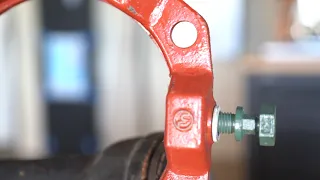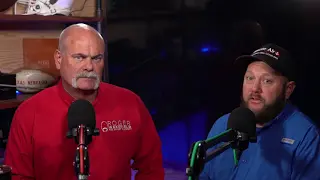As a master plumber, my plan goes beyond simply restoring this property: I’m turning it into a dedicated training facility for Leak Pro—a place where plumbers can hone their slab leak detection skills, master sewer isolation, and gain true confidence in diagnosing waterline problems.
What’s so special about 10 acres of weed-choked fields, defunct bathrooms, and old barns? Quite a bit, actually. We’ve got multiple buildings (including a barn that’ll be partially converted for training and lodging), plus enough land to lay out a custom concrete pad designed to simulate real slab leaks. Sure, the property’s got holes in the walls, questionable septic pipes, and a jacuzzi that doesn’t hold water—but that’s half the fun. Below, I’ll break down some key highlights of the property, what we’re planning to teach, and how you can follow along as we develop “The Outhouse Project” into one of the finest leak detection training centers around.
Why Buy 10 Acres of Neglect?
A Hands-On Approach to Training
Leak detection is often taught using repurposed swimming-pool gear or classroom theory, disconnected from the actual conditions plumbers face. I wanted real lines at real depths, with real water pressure, so folks can hear and see exactly what’s going on.
Room to Expand
This isn’t just a single slab. We’ve got multiple structures, so we can create different “houses,” barns, bathrooms, and even a giant open-air area to practice various leak scenarios. Plus, it gives me space to build living quarters for visiting trainees, so they can immerse themselves in multi-day courses without needing a hotel.
Endless Content for Plumbing Fans
Many of you follow my channel for plumbing tips, product tests, and the occasional comedic moment. The Outhouse Project will provide endless fodder—fixing weird old lines, discovering hidden showers, encountering critters in the barn. If you enjoy watching a plumber unravel bizarre water systems, you’ll love this.
An Overview of the Property
Five Buildings + A Concrete Pad
- House #1: Original structure, partially updated but sporting a bathroom that hasn’t worked in years.
- House #2: Slightly bigger, rumored to have extra plumbing lines we can’t fully map yet.
- Trailer: Probably for storage or future guest use. Needs an overhaul.
- Barn: Over 2,000 square feet of “opportunities”—holes in the roof, random toilets inside, and big plans for partial conversion into lodging and a workshop.
- Boat Barn: Because, why not? Currently a catch-all for junk, but it may house advanced leak detection gear.
- New Concrete Pad: Built specifically to embed custom leak scenarios—13 lines with controlled leaks at different depths and pipe sizes.
A Farmhouse Bathroom Mystery
One bathroom is basically non-functional, yet we found leftover signs of cold water lines, hot water lines, and a capped-off corner. Where does the supply come from? Why is half of it turned off? We see brand-new valves in odd spots, leftover expansions, and it’s all a puzzle. For me, unraveling this means filming every step so you can see how a seasoned plumber approaches detective work.
Hidden Shower and “Valve Box”
We discovered an odd built-in cabinet with a potential valve box at the bottom. We can’t find any actual valve there—just a recess that leads nowhere. Meanwhile, a fully walled-off shower lurks behind a patch of drywall in one building. It’s as if someone decided they didn’t want a shower anymore and just sealed it up. Leaks from that forgotten fixture might explain water stains or mold nearby.
Building the Training Center
Slab Leak Simulation
We poured a 25×60-foot slab, burying copper and PVC lines at varying depths. Each line has a small, controlled leak—about 1–1.5 gallons per minute at 70 PSI—so that plumbers can practice localizing the noise and meter-clocking. They’ll isolate lines using valves on each end, labeled “kitchen sink” or “master bath toilet,” just like in a real house.
Sewer Isolation Module
Along one edge, we laid down a “house sewer” (both PVC and cast iron) that disappears under the slab. This offers hands-on sewer leak detection: flipping test balls, controlling vents, and double-checking for illusions. No more guessing if that gurgling noise is the main or a branch line. Students will see and manipulate it directly.
Detecting the Unknown
Part of the magic is that not everything will be spelled out. Some lines might be deeper, or have smaller leaks that produce less noise—an advanced scenario. Others might be ½ inch at 12 inches deep, making them easy to detect. This variety ensures novices gain confidence while veterans stay challenged.
Barn Life and Lodging Plans
Turning the Barn into a Workshop/Residence
In the barn, we’ll design a partial living area with bunk beds, plus a bathroom with two showers and two toilets. That way, trainees can live on-site. They can spend evenings reviewing lessons, practicing advanced methods, and brainstorming with peers. The rest of the barn becomes a workshop for equipment demos, from press tools to advanced cameras.
The Mysterious “Toilet in the Barn”
We found a partially working toilet and some half-baked exhaust fan that vents… nowhere. Perhaps we’ll keep it for comedic effect or integrate it into the final design. It’s a perfect example of how random plumbing decisions sometimes occur in real projects.
Why This Matters for Plumbers Everywhere
Advanced Leak Detection Skills
Many plumbers guess where a leak is under the slab. We’ll teach a methodical, code-based approach so you can charge a premium for certainty. No more re-jackhammering or missed leaks.
Raise the Profession’s Standard
We hope to elevate the average plumber’s knowledge to a level that was once only accessible via pool-based or partial training. Our facility is purely for building-based systems, from start to finish.
Hands-On, Not Just Theory
Ever sat in a classroom hearing about leak detection but never actually used the equipment on live lines? That’s not how we do it here. You’ll see water lines, hear them, pressurize them, isolate them, and confirm your location is accurate within inches.
Roadmap: What’s Next
- Finishing the Barn
- We’ll frame the living quarters, insulate, run new plumbing lines for showers and toilets, and ensure a stable climate inside.
- We might even place glass garage doors along the front for an airy, modern vibe.
- Completing the Slab Modules
- We’ll add signage for each leak scenario, finalize valve labeling, and integrate sewer simulation.
- Possibly expand to advanced illusions: partial cracks, multiple small leaks, or tricky cross lines.
- Grand Opening
- Once everything is functional, we’ll open classes for professional plumbers and company owners.
- Expect 2–3 day intensives, limited class sizes, with real tools and real slab lines.
Squirt’s Adventures
If you watched the video, you’ll see “Squirt” (my comedic pipefitter friend) wandering around, often dramatizing spider encounters or searching for water in odd corners. He’s a big part of the comedic relief—and a testament to the unpredictability of the property. Keep an eye on him for future episodes: you never know what chunk of random piping he’ll uncover next.
Conclusion
“The Outhouse Project” is more than just me buying run-down buildings. It’s a bold move to reshape how plumbers learn leak detection—hands-on, code-accurate, and in a setting that simulates real homes. From rummaging around old bathrooms to forging an entire sewer line under a custom slab, we’re bridging the gap between textbook theory and the actual complexities you encounter under a floor.
As we progress, you’ll see new builds, comedic mishaps, and advanced plumbing demonstrations that you won’t find elsewhere. So stay tuned. Whether you’re a seasoned plumber wanting to sharpen your leak detection edge, or a curious homeowner who loves behind-the-scenes action, “The Outhouse Project” has something for everyone. And yes, we’ll keep you posted if we ever figure out how that hidden shower or random “jacuzzi that leaks” was supposed to work.




